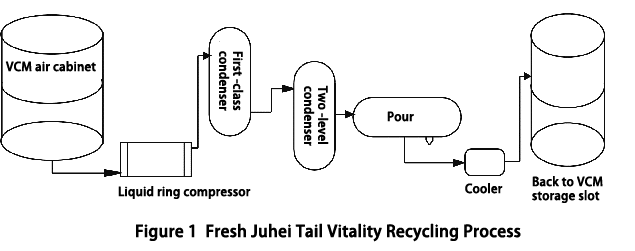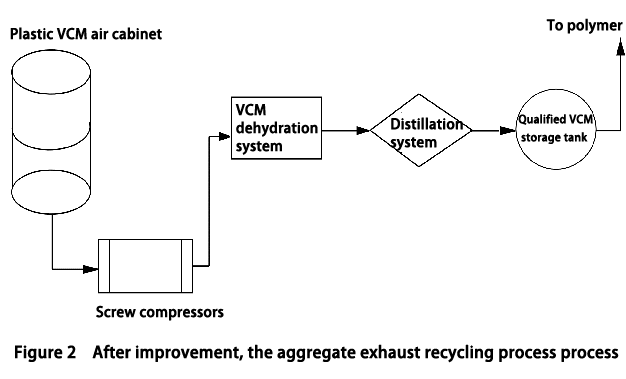PVC liquid ring compressor
Improvement of vinyl chloride monomer recovery process in PVC production
polyvinyl chloride
In the production process of PVC, there are two types of by-products, namely the tail gas generated during VCM polymerization (polymerization tail gas) and the tail gas generated during VCM distillation (distillation tail gas). Most domestic PVC production enterprises have established two independent devices for pressure swing adsorption recovery of polymerization tail gas and pressure swing adsorption recovery of VCM distillation tail gas.
1. Original polymerization tail gas recovery process and existing problems
1.1 Original polymerization tail gas recovery process
In the VCM polymerization process, when the conversion rate of the VCM reaction is between 80% and 85%, it is used as the reaction endpoint for exhaust and recovery of unreacted VCM. The unreacted VCM enters the recovery unit for processing. The supporting recovery unit uses a gas cabinet for collection, compressor boosting condensation, first stage condenser, and second stage condenser cooling. Finally, the gas-phase VCM is liquefied and collected in the recovery VCM storage tank for feeding into the polymerization kettle. The non liquefied gas-phase VCM is separated by a tail gas adsorption device, and most of the VCM is recovered to the gas tank and enters the recovery system for continued use. The remaining small amount of VCM is discharged under the premise of meeting national standards.

1.2 Problems with the original process
(1) The phenomenon of self aggregation is severe.
Due to the fact that the original VCM recycling process system only had compression, first stage condensation, and second stage condensation processes, these processes could not effectively remove moisture from the recycled VCM. However, moisture has a significant impact on the polymerization reaction, as it can hydrolyze low molecular weight peroxides generated from oxygen and vinyl chloride, producing acidic substances such as hydrogen chloride, formic acid, and formaldehyde that corrode steel equipment, and generate Fe3+present in monomers, causing the polymerized resin to turn yellow or become black spot impurities, reducing the thermal stability of PVC resin. The presence of Fe3+will promote the generation of peroxides between oxygen and VCM in the system, which can repeat the above hydrolysis process and trigger the polymerization of VCM, generating PVC with lower degree of polymerization, causing self polymerization and equipment blockage.
(2) Increase the VCM recycling load.
With the continuous rise of PVC market prices, PVC production enterprises are bound to increase production of PVC. With the continuous increase in production, residual VCM (including some inert gases) in the polymerization reactor and gas-phase VCM from equipment such as the reactor emptying pump, slurry filter, discharge tank, stripping vacuum pump, and recovery condenser will be recovered to the gas cabinet after the polymerization reaction is completed. The recovered VCM contains a small amount of PVC resin particles, low molecular weight PVC, initiators, N2, CO2, etc., of which 70% is VCM and 30% is impurity gases such as N2 and CO2. These will increase the recovery load of VCM gas cabinets, affecting the production load and safety of subsequent system devices such as liquid ring compressors, condensers, and VCM recovery tanks.
2. Polymerization tail gas recovery process of improvement
2.1 Recycling process flow
In order to solve the problems in the original polymerization tail gas recovery process, the residual gas-phase VCM after the polymerization reaction is led to the synthesis compression process, which is compressed by a screw compressor and enters the dehydration system to remove water. Then, high and low boiling substances are removed through the distillation process to obtain VCM that meets the polymerization requirements. The VCM is pumped by a monomer pump to the VCM spherical tank for storage for polymerization, forming a closed loop system to achieve the purpose of recovering VCM.

2.2 Advantages of recycling process
(1) The removal of dispersants, initiators, and other additives as well as non condensable gases from recycled VCM has improved the purity of recycled VCM and the quality of PVC products, reducing production costs.
(2) Reduced the load of VCM gas holders in the aggregation and recycling process.
(3) Reduced the storage pressure of the recycling VCM storage tank and reduced excessive consumption of the liquid ring compressor in the recycling process.
(4) This process improvement has a simple process, low construction investment, and significant economic benefits.
(The article comes from the Internet. If reprinting is not allowed, please contact our company to delete it.)
